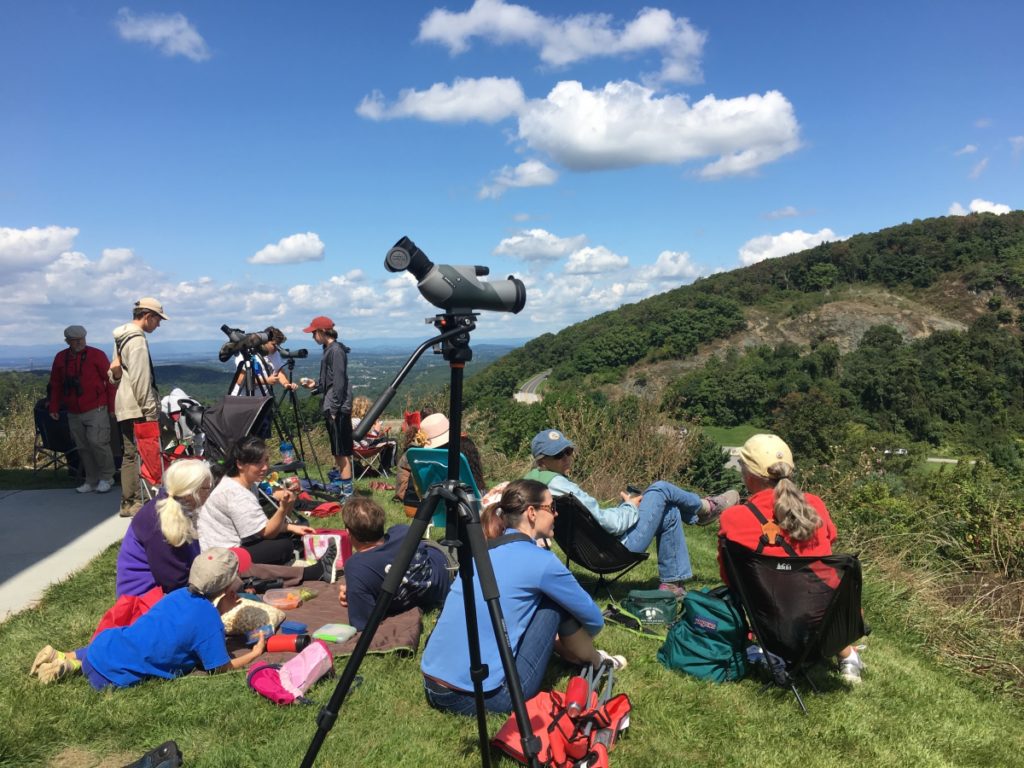
The 2017 fall hawk migration count at Rockfish Gap Hawk Watch recorded a total of 25,139 raptors, which is slightly more than our 10-year average of 23,163. Our small group of volunteer counters put in 600 hours (avg = 500) of effort between Aug 15 to Dec 1 with a total of 82 days (avg = 75) that were counted.
Among our common migrants, a new season record was set for BALD EAGLE with 329 (previous record = 304 in 2016, avg = 174). A single-day high of 32 Bald Eagles occurred on Sep 3, crushing our previous record of 19 on 9/14/2010! Our OSPREY count of 227 was a little lower than the 249 average. Our NORTHERN HARRIER count of 53 was lower than the 61 average. In terms of accipiters, our SHARP-SHINNED HAWK count of 996 was quite lower than the 1,660 average, and our COOPER’S HAWK count of 253 was slightly lower than the 263 average. In terms of buteos, we had a good RED-SHOULDERED HAWK count of 110 (avg = 66), which was the third-highest count and only the third time that the count surpassed 100. Our BROAD-WINGED HAWK count of 22,341 was a little higher than the 19,709 average. Keep in mind that the Broad-winged Hawk numbers comprise 85% of our season’s total raptor count on average. Our RED-TAILED HAWK count was quite low this year with only 510 (avg = 651). In terms of falcons, our AMERICAN KESTREL count of 120 was quite lower than the 206 average. However, we set a new season record for MERLIN with 53 counted (avg = 29, previous record = 51 last year), and our PEREGRINE FALCON count of 34 was higher than the 29 average.
Among our uncommon raptors, we were lucky to have observed not one but two ROUGH-LEGGED HAWKs this season: a light-phase on Oct 28 and a dark-phase on Nov 14 (only 11 have ever been recorded, and only one other time have we observed two in one season). Our MISSISSIPPI KITE count of 3 is only the third time that more than one was observed in a season (only 17 have ever been recorded). Our NORTHERN GOSHAWK count of 10 was above the average of 4. Finally, our GOLDEN EAGLE count of 30 was the second-highest ever (highest count was 40 in 2014, avg = 14).
This year we observed a total of 111 non-raptor species. Uncommon migrants this season included: 10 Snow Goose, 2 Greater White-fronted Goose, 4 Tundra Swan, 7 Common Loon, 1 Sandhill Crane, 2 Ring-billed Gull, Black-billed Cuckoo, 8 Bank & 3 Cliff Swallow, 1 Summer Tanager, 32 Rusty Blackbird, and 1 very photogenic Marsh Wren. Migrating fall warblers entailed the following 22 species: American Redstart, Prairie, Tennessee, Cape May, Northern Parula, Black-throated Green, Black-throated Blue, Wilson’s, Black-and-white, Common Yellowthroat, Magnolia, Blackburnian, Chestnut-sided, Bay-breasted, Yellow-rumped, Blackpoll, Palm, Pine, Orange-crowned, Hooded, Nashville, and Canada. We counted a total of 332 Ruby-throated Hummingbirds migrating through the gap this fall. Other notable migrants this season included: 190 Double-crested Cormorant, 245 Common Nighthawk, 3,714 Chimney Swift, 115 Red-headed Woodpecker, 239 Northern Flicker, 856 Blue Jay, 240 Tree Swallow, 245 Barn Swallow, 4,470 American Robin, 6,365 Cedar Waxwing, 2,597 Red-winged Blackbird, 1,797 Grackle, and 82 Raven. Finally, we were very happy to see that our Monarch Butterfly season count of 1,418 was up again this year.
